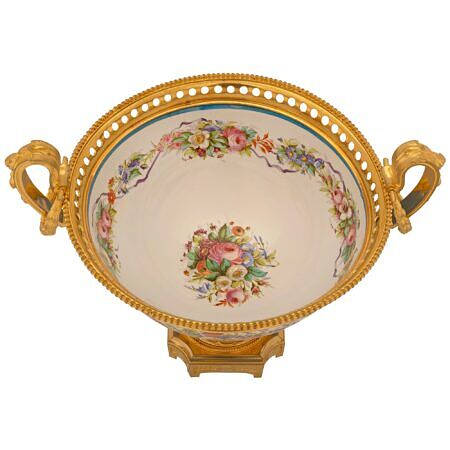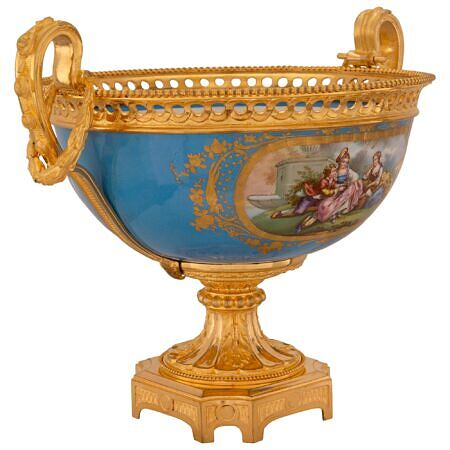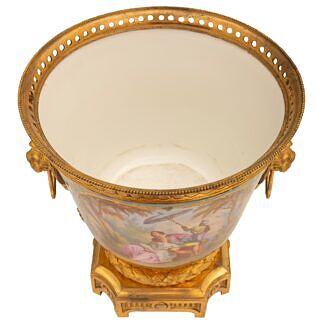A French 19th century Louis XVI st. Sèvres porcelain and ormolu centerpiece
List: $8,900.00
A beautiful and most elegant French 19th century Louis XVI st. Sèvres porcelain and ormolu centerpiece. The oblong shaped centerpiece is raised by a square ormolu base with arched sides, concave corners, fine fluted designs, and a striking fluted foliate... — Read More
A beautiful and most elegant French 19th century Louis XVI st. Sèvres porcelain and ormolu centerpiece. The oblong shaped centerpiece is raised by a square ormolu base with arched sides, concave corners, fine fluted designs, and a striking fluted foliate socle shaped pedestal support with a wrap around beaded band. The Sèvres porcelain body displays a lovely scene of two young ladies and a young man dressed in flowing period attire lying outside with a house and fountain in the background on one side and wonderfully executed colorful blooming flowers on the other each framed within a foliate gold tooled border and set on a lovely blue background. Elegant ormolu handles lead up each side with delicate fluted designs with a swaging berried laurel wreath and connecting to the striking pierced wrap around ormolu band at the rim displaying remarkable geometric interlocking and beaded wrap around bands. The centerpiece is also finished on the inside displaying exceptional intricately detailed hand painted colorful blooming flowers. — Read Less
- Item # 12883
-
H: 14 in L: 18 in D: 13.5 in
H: 36 cm L: 46 cm D: 34 cm
- France
- 19th Century
- Ormolu, Porcelain
- Louis XVI st. Read More
- Sèvres Read More
It was founded through the support of King Louis XV of France and at the initiative of Madame Pompadour to be located near her Château.
Due to Sèvres’ reputation for excellence and prestige, it has always attracted some of the best artists throughout history; François Boucher, Albert-Ernest Carrier-Belleuse, Étienne Maurice Falconet, Alexandre Fragonard and August Rodin, just to name a few. Many of these artworks can be seen at the Louvre Museum and the Musée National de Céramique in France.
Initially, Sèvres created a soft paste porcelain know as Biscuit de Sèvres. In 1768 the Bordeaux chemist Villaris and Jean Baptiste Darnet discovered deposits of Kaolin on French soil. In 1771 the Royal Academy sent a report on the creation of hard paste porcelain at which time Sèvres began manufacturing hard paste porcelain.
Louis-Simon Boizot (1743–1809) was a French sculptor renowned for creating Biscuit de Sèvres models, and was the director at Sèvres from 1774-1800, followed by Alexandre Brogniart(1800-1847) and Henri Victor Regnault in 1854.
Related products
-
# 13263 - H: 14" L: 18" D: 12"
-
# 7489 - H: 14" L: 17" D: 12"
-
# 10490 - H: 13" L: 14" D: 11"
-
# 3332 - H: 10" L: 10" D: 9"
Recently Viewed View All
-
# 12694 - H: 20" L: 51" D: 24"
-
# 7165 - H: 31" L: 82" D: 42"
-
# 13115 - H: 30" L: 168" D: 50"
-
# 12763 - H: 50" L: 41" D: 5"









































